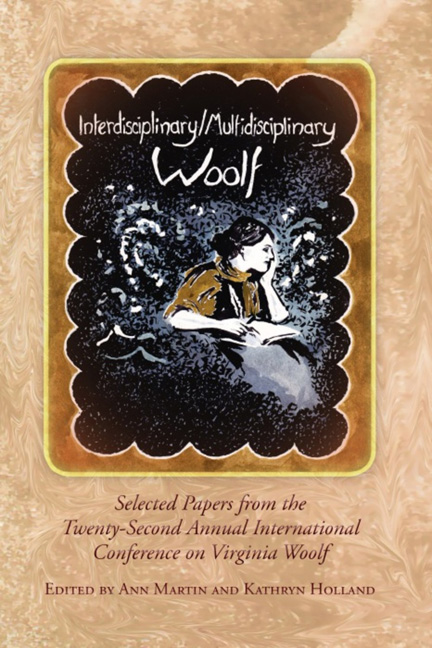Book contents
- Frontmatter
- Contents
- Introduction to Interdisciplinary/Multidisciplinary Woolf
- Acknowledgments
- List of Abbreviations
- History, Materiality, Multiplicity
- Patterns, Practices, Principles
- “Waving to Virginia”
- Woolf, Defoe, Derrida: Interdisciplinary dogs—or the canine aesthetics and (gender) politics of creativity
- “The law is on the side of the normal”: Virginia Woolf as Crip Theorist
- A Healing Centre of One's Own: Woolf's Legacy and Public Responses to Child Abuse
- Sunflower Suture: Disseminating the Garden in The Years
- “One Must Be Scientific”: Natural History and Ecology in Mrs. Dalloway
- Clarissa's Glacial Skepticism: John Tyndall and “Deep Time” in Mrs. Dalloway
- Apollonian Illusion and Dionysian Truth in Mrs. Dalloway
- Art, Influence, Embodiment
- Publishing, Politics, Publics
- Notes on Contributors
- Conference Program
Sunflower Suture: Disseminating the Garden in The Years
from Patterns, Practices, Principles
- Frontmatter
- Contents
- Introduction to Interdisciplinary/Multidisciplinary Woolf
- Acknowledgments
- List of Abbreviations
- History, Materiality, Multiplicity
- Patterns, Practices, Principles
- “Waving to Virginia”
- Woolf, Defoe, Derrida: Interdisciplinary dogs—or the canine aesthetics and (gender) politics of creativity
- “The law is on the side of the normal”: Virginia Woolf as Crip Theorist
- A Healing Centre of One's Own: Woolf's Legacy and Public Responses to Child Abuse
- Sunflower Suture: Disseminating the Garden in The Years
- “One Must Be Scientific”: Natural History and Ecology in Mrs. Dalloway
- Clarissa's Glacial Skepticism: John Tyndall and “Deep Time” in Mrs. Dalloway
- Apollonian Illusion and Dionysian Truth in Mrs. Dalloway
- Art, Influence, Embodiment
- Publishing, Politics, Publics
- Notes on Contributors
- Conference Program
Summary
The Years is a book about patterns of repetition in human lives and in the natural world in which artificial and metaphorical flowers as well as their living exemplars act as vivid elements in an intricate fugue of reiterated motifs. Predominately a city novel, The Years is also one of Woolf's most floral fictions, with twenty-four varieties of flower named, almost as many as Orlando (25) and Jacob's Room (35), and more actual flowers mentioned (91) than any book except Mrs. Dalloway ( 102). Perhaps because of the urban setting, the possibilities of the pastoral seem to recede rather precipitously in The Years ; gardens appear only infrequently, continuing to serve as places of refuge and sites for romantic meetings, but often pushed to a remote periphery or existing only in a dimly remembered past. Flowers in The Years function on many familiar levels: as elements of the natural cycle of seasons whose rhythm shapes the novel, as emblems of girlhood, as reminders of and connections to traditions of the past, and as markers of temporal transitions. More than in any previous novel, however, a large proportion of flowers are artificial, metaphorical, or literary artifacts in poetry or song, their unnaturalness making it easier to create unexpected thematic alignments. Those actual, living flowers that do remain are often dislocated or decapitated, suggesting that the traditional story of female development is being radically de-naturalized.
Sunflowers are mentioned only three times in The Years, yet these references to the terracotta plaques stamped on the doors of Eleanor's low-income houses serve symbolically to stitch together several major themes of the novel, the contradictory symbolic implications of the sunflower as both an emblem of the Goddess and as a type of excessively devoted loyalty serving to delineate alternative female roles, while a particularly fascinating visual analogy of the sunflower with the figure of a rayed dot drawn by Eleanor provides new insight into the centripetal structure of the novel as a whole.
Sunflowers first appear in the autumnal 1891 section of The Years, when Eleanor visits her low-income houses in Peter St. Her particular houses are distinguished from the others by their green sills and the terra-cotta “plaque[s] with a sunflower stamped…over the door” (91).
- Type
- Chapter
- Information
- Interdisciplinary/Multidisciplinary Woolf , pp. 119 - 126Publisher: Liverpool University PressPrint publication year: 2013



